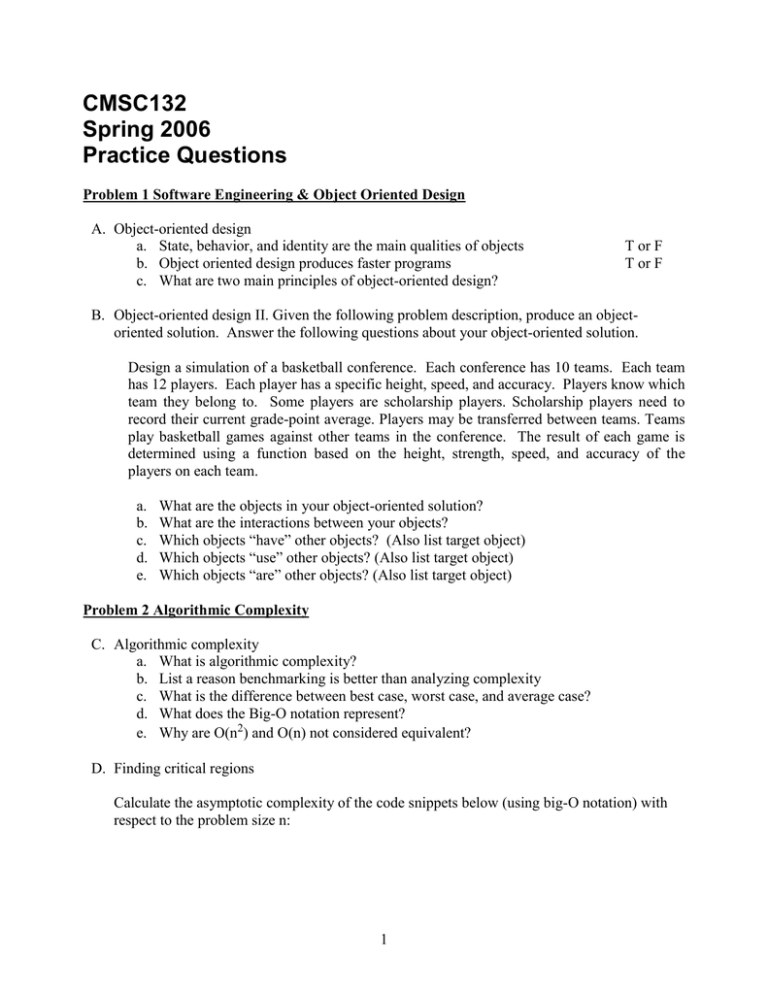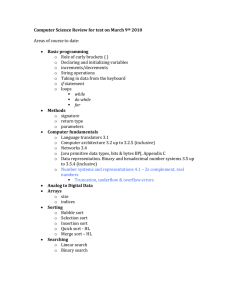Practice3.doc
advertisement

CMSC132
Spring 2006
Practice Questions
Problem 1 Software Engineering & Object Oriented Design
A. Object-oriented design
a. State, behavior, and identity are the main qualities of objects
b. Object oriented design produces faster programs
c. What are two main principles of object-oriented design?
T or F
T or F
B. Object-oriented design II. Given the following problem description, produce an objectoriented solution. Answer the following questions about your object-oriented solution.
Design a simulation of a basketball conference. Each conference has 10 teams. Each team
has 12 players. Each player has a specific height, speed, and accuracy. Players know which
team they belong to. Some players are scholarship players. Scholarship players need to
record their current grade-point average. Players may be transferred between teams. Teams
play basketball games against other teams in the conference. The result of each game is
determined using a function based on the height, strength, speed, and accuracy of the
players on each team.
a.
b.
c.
d.
e.
What are the objects in your object-oriented solution?
What are the interactions between your objects?
Which objects “have” other objects? (Also list target object)
Which objects “use” other objects? (Also list target object)
Which objects “are” other objects? (Also list target object)
Problem 2 Algorithmic Complexity
C. Algorithmic complexity
a. What is algorithmic complexity?
b. List a reason benchmarking is better than analyzing complexity
c. What is the difference between best case, worst case, and average case?
d. What does the Big-O notation represent?
e. Why are O(n2) and O(n) not considered equivalent?
D. Finding critical regions
Calculate the asymptotic complexity of the code snippets below (using big-O notation) with
respect to the problem size n:
1
a. for (i = 0; i < n; i=i*2) {
for (j = 1; j < n; j++) {
...
}
}
f(n) = O(
)
b. for (i = 0; i < n-2; i++) {
for (j = 0; j < n; j=j*2) {
for (k = 1; k < 5000; k=k*5) {
...
}
}
for (j = 0; j < 1000*n; j=j+1) {
...
}
for (j = 0; j < n/5; j=j+5) {
...
}
}
f(n) = O(
)
Problem 3 Data Structures and Recursion
E. Taxonomy & properties
a. Describe the main difference between linear and hierarchical data structures
b. What is the key property of a binary search tree?
c. On average, what is the complexity of doing an insertion in a binary search tree?
d. Pre-order, in-order, and post-order are all depth-first traversals
T or F
e. What operation(s) supported by binary search trees are not supported by heaps?
f. What is the difference between a set and a map?
g. What happens when an open addressing hash table is close to full?
h. Describe the 2 main parts of a recursive algorithm
Problem 4 Graph Algorithms
F. Properties
a. Describe the main difference between hierarchical and graph data structures
b. Describe the difference between a directed and undirected graph
c. Describe the difference between a path and a cycle
d. Describe two methods of storing edges in a graph
e. Which method of storing edges in a graph requires more space?
G. Traversals
a. Why is graph traversal more difficult than a tree traversal?
b. Describe the difference between a breadth-first and depth-first traversal of a graph
c. Given the following Java class definition for a graph
2
public class MyGraph<E> {
public class Node<E> {
E myValue;
boolean tag;
ArrayList<Node> myNeighbors;
}
ArrayList<Node> myNodes;
void visitNode(Node n)
{/* Action to be performed when traversing node */}
void deptFirstSearch(Node n) { /* Perform depth-first search of graph starting at n */ }
}
i. Write code for the method depthFirstSearch( n ) that performs a depth first traversal
starting at node n.
ii. Write code for the method breadthFirstSearch(n) that performs a breadth first traversal
starting at node n.
H. Minimum spanning trees
a. What is a spanning tree?
b. Describe Kruskal’s algorithm for finding minimum spanning trees
c. Describe Prim’s algorithm for finding minimum spanning trees
d. Describe two methods for finding connected subgraphs
e. Consider the following graph. Using Kruskal’s algorithm, calculate the minimum
spanning tree, listing edges in the minimal spanning tree in the order they are added to
the tree.
f. Repeat e. using Prim’s algorithm.
16
S
10 A
12
C
D
B
4
6
7
G
15
E
8
14
9
13 5
3
F
H
11
I. Single source shortest path
a. Describe Djikstra’s algorithm for finding shortest paths in a graph
b. Consider the previous graph. Apply Djikstra’s algorithm for this graph to calculate the
shortest path from S to every other node. Store intermediate results in the table
3
BestKnownDistances. Show the entries in the table after you finish computing the
shortest distance from S to nodes in the set {S, A, B}.
Table BestKnownDistances
S
A
B
C
D
E
F
G
H
LowestCost
Predecessor
c. Which node would be processed next using Dijkstra’s algorithm?
d. Update the table BestKnownDistances after adding this node.
e. Using Dijkstra’s algorithm, calculate the shortest path (and its cost) from S to every
other vertex in the graph. List vertices in the order they are added to the table
BestKnownDistances.
Problem 5 Compression & Huffman Codes
J. Compression
a. What are two sources of compressibility?
b. What are two types of compression?
c. What is a prefix code?
d. What are Huffman codes?
e. How do Huffman codes achieve compression?
f. Given the following Huffman tree, decode the sequence “00110010”
T
S
1
0
1
R
0
1
A
0
g. Using the same Huffman tree, encode the string “arts” as a sequence of 0’s and 1’s
h. Given the following symbol frequencies, create a Huffman tree for the symbols
A = 5, B = 8, C = 4, D = 6, E = 7
4
Problem 6 Java Language Features
K. Regular expressions in Java
a. What are regular expressions?
b. What is the motivation for using regular expressions?
c. Given the following Java code fragment using java.util.regex:
Pattern p = Pattern.compile(“[a-z]+”);
Matcher m = p.matcher(“a0 ab5 42 cd ef13”);
while (m.find()) { System.out.print(m.group() + “\n”); }
What will be printed out when the code is executed?
d. Given the following Java code fragment using java.util.regex:
Pattern p = Pattern.compile(“[a-z0-9]+”);
Matcher m = p.matcher(“a0 ab5 42 cd ef13”);
while (m.find()) { System.out.print(m.group() + “\n”); }
What will be printed out when the code is executed?
e. Given the following Java code fragment using java.util.regex:
Pattern p = Pattern.compile(“[a-z]+[0-9]”);
Matcher m = p.matcher(“a0 ab5 42 cd ef13”);
while (m.find()) { System.out.print(m.group() + “\n”); }
What will be printed out when the code is executed?
L. Exceptions in Java
a. What are exceptions?
b. How are exceptions used in Java?
c. What should be made an exception in Java?
d. What are the differences between try, catch, and finally in Java?
e. Given the following code
public static void f( int y ) {
try {
System.out.print(“A”);
int x = 1 / y ; // generates ArithmeticException if y == 0
System.out.print(“B”);
}
catch (ArithmeticException e) {
System.out.print(“C”);
}
5
finally {
System.out.print(“D”);
}
}
What will be printed for the following method calls?
1. f(1)
2. f(0)
Problem 7 Multithreading & Synchronization (20 pts)
M. Multithreading
a. What is the motivation for writing multithreaded Java code?
b. What are possible states for Java threads?
c. What is the effect of invoking the start( ) method of the Thread class?
d. What is scheduling?
e. What is the difference between preemptive and non-preemptive scheduling?
f. What are data races?
g. Why should programs avoid data races?
N. Synchronization& deadlocks
a. What is synchronization?
b. Why should programs use synchronization?
c. What are Java locks?
d. What are deadlocks?
e. Why should programs avoid deadlocks?
f. What are Java wait( ) and notify( ) methods?
g. What is the effect of invoking the wait( ) method?
O. Multithreading code
Consider the following code:
public class mySet {
List myElements = new ArrayList( );
public boolean add( Object o ) {
myElements.add( o );
}
public Object remove( ) {
if (myElements.isEmpty( ) == false)
return myElements.remove( 0 ); // removes & returns object at position 0
return null;
}
}
6
a. What may happen if an object of the class mySet is used by multiple threads calling
add( ) and remove( ) at the same time?
b. Change the add( ) and remove( ) methods so that the class mySet can be safely used by
multiple threads at once.
c. Change the add( ) and remove( ) methods so that the method remove( ) will always
return an object when used by multiple threads (by waiting until an object has been
added).
Problem 8 Sorting & Algorithm Strategies
P. Sorting algorithms
a. What is a comparison sort?
b. When is a sorting algorithm not a comparison sort?
c. What is a stable sort?
d. What is an in-place sort?
e. What is an external sort?
f. What is the average case complexity of sorting using
i. bubble sort
ii. heap sort
iii. quick sort
iv. counting sort
g. What is the worst case complexity of sorting using
i. selection sort
ii. tree sort
iii. heap sort
iv. radix sort
h. Can the following sort be performed in a stable manner?
i. bubble sort
ii. quick sort
iii. counting sort
i. Can the following sort be performed using an in-place algorithm?
i. selection sort
ii. tree sort
iii. merge sort
7


